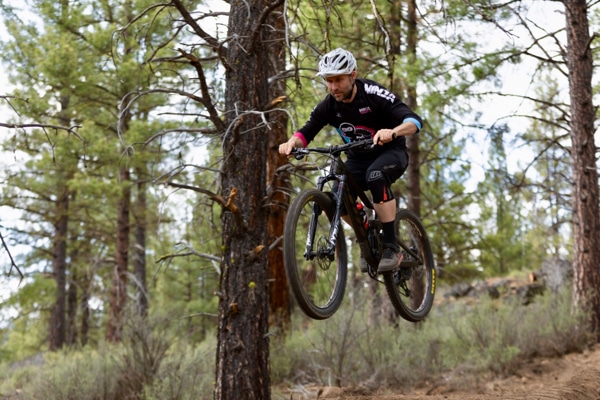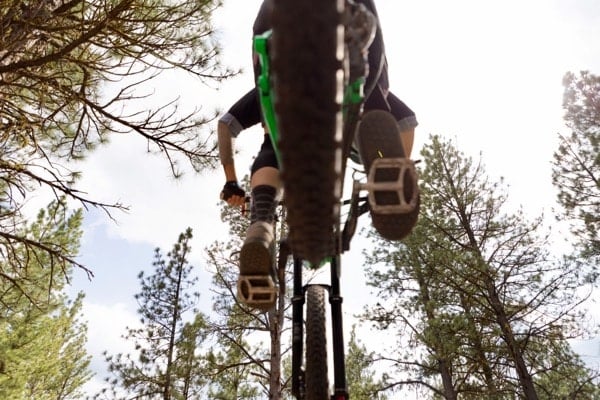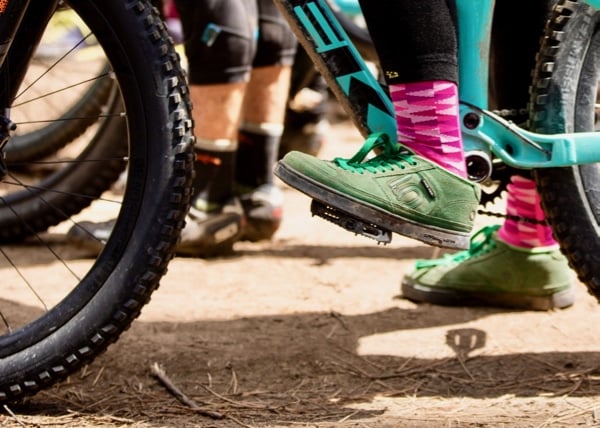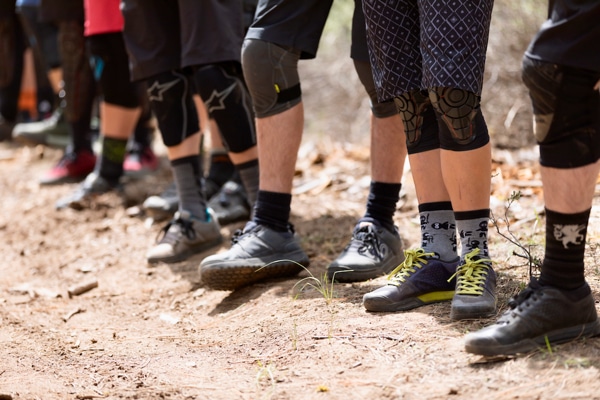5 Tips for Keeping Your Feet on The Pedals While Jumping
Have you ever felt your feet come off the pedals while you’re jumping? Scary, right? Here are the 5 key components to keeping your feet on the pedals and keeping your heart from racing.

1. Technique
The most common reason we see feet coming off the pedals is because the rider’s body is coming up faster than their bike, or the body is too stiff and ends up pushing the bike away from the body. When jumping, you have to allow the bike to travel upwards towards your body by bending your arms and legs and drawing the bike up towards you. This requires you to be relaxed, not tense.
Do you ride clipless pedals? People who ride clipped into their pedals are often unaware that they’re relying on that clipped connection to bring the bike up in the air. It’s important that all riders, with both clipless and flat pedals, learn proper jumping technique for scalable success.
Maintain contact with your pedals by creating tension between your pedals and handlebars. This is achieved by pointing your toes down slightly and dragging backward on the pedals (but not too hard, just a little should do the trick!)

2. Compression
To keep your feet connected to your pedals while jumping, make sure you’re compressing at the right time. Nailing the timing of your compression is key! Compress down into your bike right before you begin the transition up the face of the jump. Compress too early or too late and you run the risk of things feeling pretty wacky, and potentially losing that foot/pedal connection.
You can practice perfecting the timing of your compression with a simple level lift. A level lift is when you bring both wheels off the ground at the same time (as opposed to just a front or rear wheel lift). Practice a level lift in a flat or slightly descending area. STOMP down on your pedals (compression) and allow both wheels and the bike to come up under you. They should come up evenly, hence the name “level” lift.
If you aren’t 100% sure when you should be compressing on a jump, have a quick read of the What, Why, and How of Jumping.
3. Suspension
If your suspension isn’t set up correctly, it will make it more difficult to perfect the timing of the compression. Head over to Suspension Setup in 4 Easy Steps to get yours dialed.

4. Foot Placement (flat pedals)
You should place your foot on the pedal so that the axle of the pedal sits just behind the ball of your foot. This differs to how you would place your foot with clipless pedals and will help to prevent you from springing up and off of the pedals if you extend your foot downwards.

5. Gear
Good shoes and pedals are vital for maintaining contact with your bike. Purpose-built bike shoes work far better than any kind of tennis or skate shoe and mountain bike-specific flat pedals (not the $10 plastic platform pedals) are a MUST for jumping. Good shoes and pedals are specifically designed to help everything stick together, when combined with proper technique.
Don’t forget, Ninja is here to help take the fear out of flight! Join us for a Jumping Mini Clinic for direct, real-time feedback from a certified instructor on how to break bad jumping habits, keep those feet on the pedals and soar with confidence.






”This differs to how you would place your foot with clipless pedals”
No, clipless mountain pedals are best with foot placement behind the ball of the foot as well. It just took shoe makers many years to move cleat channels back.
Thank you for posting this essential information. For some reason pedal contact is overlooked in most how-to videos and I struggled with this for a long time.
Have you ever had a situation where your bike is difficult to pedal like I am? There are cases where I can barely turn my pedals. After consulting a number of experts in the field, I figured out why my bike was hard to pedal. The first is to mention the common causes you can encounter such as a rusty chain, a flat tire, or a tire with low air pressure. If you have a brake misalignment, the brake rubs against your bike’s rotor or rim. If you have wheels that aren’t realistic, you’ll notice that they wobble from side to side. This can also lead to difficult riding as your wheels no longer maintain the proper tension between the spokes. Bicycle gears have an important influence on your overall cycling experience. Even single-speed bikes can be difficult to pedal.
What about jumping an ebike? Does the xtra weight of the bike make it harder to rise up at the same time as your body?
The weight of an e-bike may require you to use an even more explosive compression (stomp) to get the rebound you need, but it is definitely still possible the jump an e-bike. Your suspension setup can also have a big impact on your jumping – – you might find this article on suspension setup helpful: https://ridelikeaninja.com/2018/01/24/what-you-didnt-know-about-your-suspension-setup/